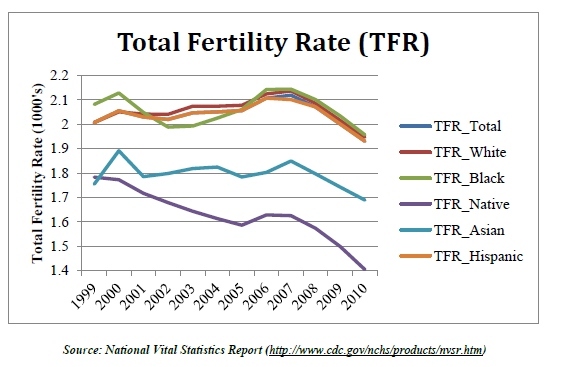
The recent economic crisis has played an important role in the decision of parents to have children. In a recent survey released by the Center for the Next Generation and Parents magazine, 1 in 5 parents indicated that they made the decision not to have another child due to the economic crisis. The Center for the Next Generation compiled data on fertility trends over the last decade that indicate that during periods of economic recession there is a general decline in the number of births. Data released by the U.S. government shows that 2011 had the lowest birth rate in history. As reported by Time magazine, this trend may led to a Europe-like situation where birth rates have continuously been declining since the last decade.
The Total Fertility Rate is measured by the average number of children a woman would have during her lifetime if the birth rate of a particular year were to remain constant. The graph above shows that the period between 2007-2010 had one of the sharpest rates of decline. These findings are important, since 90 percent of parents surveyed feared that there aren't enough jobs that pay enough to support a family. This high level of pessimism about the economy may help explain the sharp decline in the Total Fertility Rate. During the Great Depression, similar drops in birth rates occurred as shown in the graph below and they never recovered.

Research has shown that birth rates are a barometer of national well-being, since the number of children born reflects long-term trends in employment, taxation, income supports for the elderly (e.g. Social Security) and overall economic dynamism in coming generations.
The Competition that Really Matters, a report released by the Center for the Next Generation and the Center for American Progress, showed that the U.S. can only remain competitive in the global landscape by preparing the next generation of American workers through a "willingness to invest in policies to boost educational skills and attainment, improve children's health, reduce child poverty and increase parents' ability to support and care for their children." However, it is important that we discuss what that future workforce will look like through its potential growth and labor participation rates. This is why the recession and its long-term effects on birth rates are important. Declining birth rates will have serious implications on social welfare programs like Social Security, since a decrease in the labor participation rate and an increase in the rates of retirement will make such programs almost insolvent.
If you are interested in learning more about this issue, please visit toosmall.com or the Center for the Next Generation, www.tcng.org.
